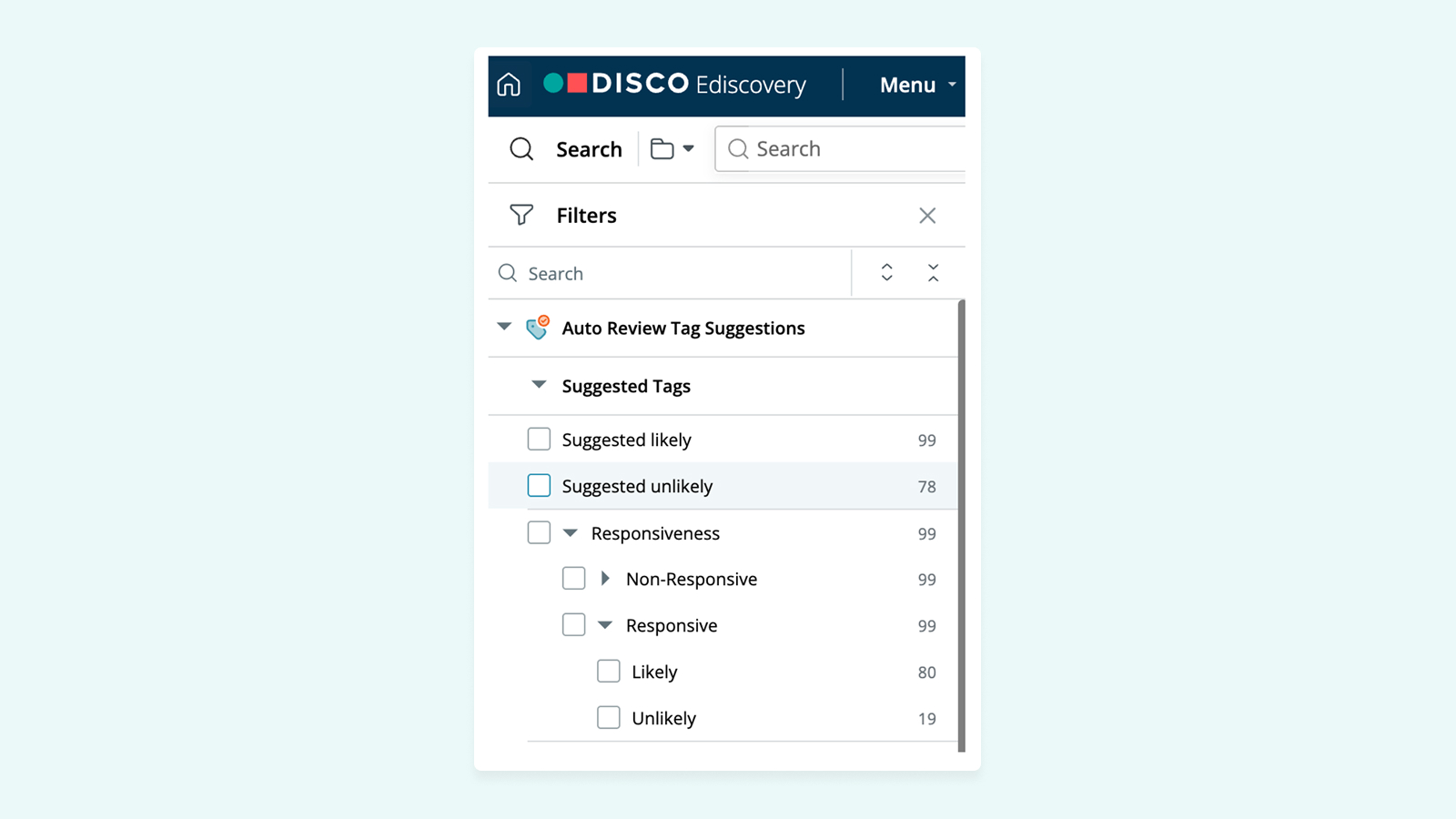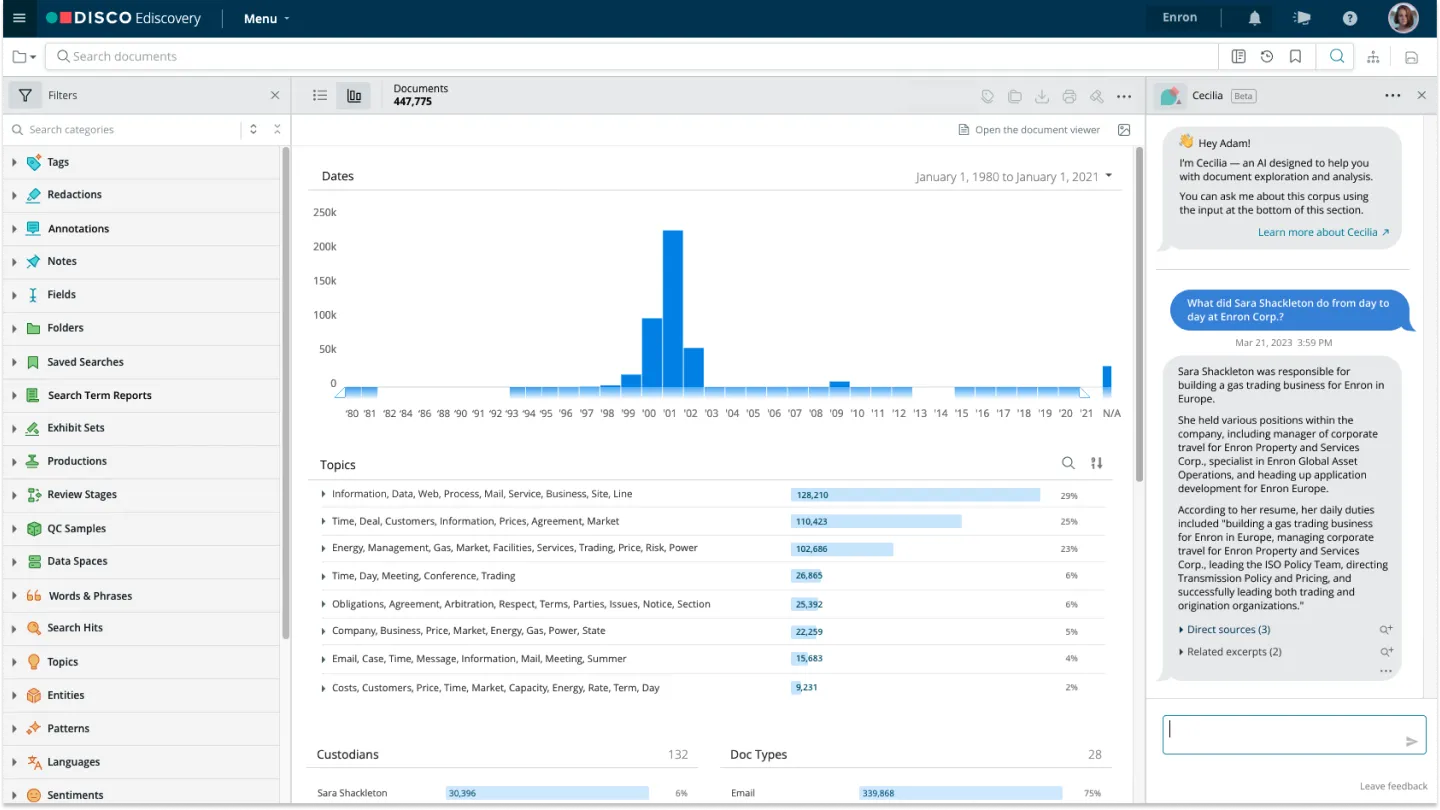⚡️ 1-Minute DISCO Download
Ediscovery and digital forensics are closely related approaches for processing digital evidence. Their apparent similarities sometimes lead legal teams to confuse the two when handling court proceedings and legal investigations. However, they are different approaches, each with distinct and unique functions.
Understanding their differences, together with knowing which to use and when, is crucial to ensure that proper procedures and standards are followed, appropriate methodologies and tools are used, and resources are allocated efficiently.
In this blog, we will explore the differences between ediscovery and digital forensics services, compare the key tools and technologies for each, and explain how common pain points can be resolved. We will also explore situations where the two approaches may be combined, in what is sometimes referred to as ediscovery forensics.
Key facts about ediscovery and digital forensics
Ediscovery and digital forensics both deal with collecting, preserving and analyzing electronically stored information (ESI) in support of legal proceedings. Both must comply with relevant laws, regulations, and legal standards to ensure the admissibility of evidence in court.
Ediscovery is the process of identifying, collecting, preserving, and analyzing ESI to be produced for discovery in court proceedings. It is commonly used in civil litigation but also plays a role in internal investigations, regulatory investigations, and due diligence during mergers and acquisitions.
Digital forensics is the process of identifying, collecting, preserving, and analyzing ESI to uncover evidence in the course of a legal investigation. It is commonly used in criminal investigations, particularly those involving cybercrime, but also plays a role in fraud detection and data breach investigations.
Exploring the differences between ediscovery and digital forensics
Ediscovery follows the rules of civil procedure and focuses on gathering and organising relevant and important data to be submitted for review. The data collection process isn’t strict, only requiring that the methods used are recorded.
Ediscovery in civil litigation follows a standard nine-stage process outlined in the Electronic Discovery and Reference model (EDRM):
- Information Management: Electronic data must be properly captured and stored in accordance with the Information Governance Reference Model (IGRM).
- Identification: Potential sources of electronic data which might be relevant to the case are located together with details of their location, storage type, and custodians.
- Preservation: Custodians of all relevant electronic data are notified that they are required to retain related physical and electronic documents to secure potential evidence.
- Collection: Relevant electronic data is forensically collected with legally defensible methods, usually through engaging specialist ediscovery experts.
- Processing: The ediscovery experts clean up the electronic data by deleting irrelevant information, converting files, and organising it into folders.
- Review: The electronic data is reviewed by a legal team to evaluate which documents are relevant, whether they are disclosable, and if redactions are needed.
- Analysis: Various AI tools are used to help lawyers extract intelligence from often complex data sets with the aid of visualisations, analytics, and reports.
- Production: The ediscovery experts work with the legal team to deliver a disclosable set of documents to be used in legal proceedings.
- Presentation: The documents are presented during legal proceedings using trial presentation software.
Ediscovery in internal or regulatory investigations follows the EDRM model with the following additional considerations:
- Responding to regulatory requests with appropriate scope and timing.
- Managing cross-border data transfer issues.
- Applying proportionality principles when negotiating with regulators.
- Establishing protocols for ongoing compliance.
Ediscovery in mergers and acquisitions follows the EDRM model with the following additional considerations:
- Handling large data volumes across different systems.
- Meeting tight transaction deadlines.
- Preserving confidentiality during sensitive negotiations.
- Complying with cross-border privacy regulations.
Ediscovery in arbitration and mediation follows the EDRM model with the following additional considerations:
- Information sharing is typically voluntary and cooperative.
- The mediator may help parties identify what information would be useful to exchange.
- Parties often agree to exchange key documents before mediation sessions.
Digital forensics follows the rules of criminal procedure and focuses on recovering and analyzing deleted and tampered data to build timelines and confirm hypotheses. The data collection process is strict to ensure the evidence has integrity and authenticity.
Digital forensics in criminal investigations follows a four-stage process:
- Identification: All electronic devices that might hold relevant data must be identified, for example laptops, smartphones, servers, and networks.
- Preservation: Potentially relevant data is extracted by creating an exact digital copy known as a “forensic image.”
- Analysis: The extracted data is meticulously analyzed for evidence of wrongdoing.
- Documentation: The findings are documented to provide a clear and comprehensive overview of the investigative process.
Digital forensics covers a range of mediums including:
- Hard drive
- Operating system
- Web browser history
- Metadata
- Database
- Cloud
- Network
- IoT
- Malware
The digital forensics process incorporates a variety of advanced tools and techniques including:
- Steganalysis: To extract hidden or deleted data.
- File carving: To recover files which have been deleted or formatted.
- Network forensics: To analyse network traffic for malicious activity.
- Mobile forensics: To examine activity on mobile devices.
- Stochastic forensics: To reconstruct digital activity in the absence of available data.
In criminal investigations, timelines are created to chronologically order digital artifacts and events, helping investigators to reconstruct events as they happened.
Ediscovery vs Digital Forensics: Comparing tools and technologies
The tools and technologies used in ediscovery and digital forensics both deal with the collection, processing, and analysis of digital evidence. While there are some similarities between ediscovery and digital forensic tools, they are tailored to meet the specific needs of their respective fields.
Ediscovery tools and technologies
Ediscovery tools and technologies focus on gathering large volumes of readily accessible data for legal proceedings. The main categories of ediscovery tools are:
Artificial intelligence (AI)
Artificial Intelligence (AI) significantly enhances efficiency, accuracy, and cost-effectiveness in legal proceedings.
The primary functions of AI in ediscovery include: document review and classification, data processing and analysis, advanced search capabilities, early case assessment, data collection and preservation.
Data processing
Data processing transforms raw electronic data into a manageable and usable format for legal proceedings.
The primary functions of data processing in ediscovery include: data reduction, data organisation, format conversion, metadata extraction, enhancing searchability, ensuring data integrity, and streamlining review.
Archiving and management platforms
Archiving and management platforms provide essential functions for storing, organizing, and retrieving electronically stored information (ESI).
The primary functions of archiving and management platforms in ediscovery include: centralized data storage, data preservation, automated archiving, indexing and search, data processing, review and analysis.
Internal search applications
Internal search applications allow legal teams to efficiently identify and collect relevant ESI across various data sources within an organization.
The primary functions of internal search applications in ediscovery include: data identification and collection, automated discovery process, advanced search capabilities, data analysis and review, and internal investigations.
Collection and preservation software:
Collection and preservation software allows legal teams to efficiently manage large volumes of data, ensure defensible practices, and reduce the risk of data spoliation.
The primary functions of collection and preservation software in ediscovery include: collecting live data, reconstructing chat conversations, gathering third-party data, implementing legal holds, safeguarding data, and ensuring legal and regulatory compliance.
Digital forensics tools and technologies
Digital forensic tools focus on deeper analysis of hidden data on individual devices, often in the course of criminal investigations. The main categories of digital forensic tools are:
Disk imaging
Disk imaging creates a comprehensive, bit-by-bit copy of storage devices, capturing all data including active files, hidden files, meta data, and file system details.
The primary functions of disk imaging in digital forensics include: preservation of the original evidence, comprehensive data capture for event reconstruction, facilitation of safe forensic analysis, and ensuring legal admissibility of digital evidence in court.
File carving and analysis
File carving and analysis is used to recover files from storage media based on the file’s content rather than its metadata.
The primary functions of file carving and analysis in digital forensics include: recovery of deleted or hidden files, extracting data from unallocated storage areas, and reconstructing files from damaged storage media.
Memory analysis
Memory analysis involves examining the contents of a computer’s volatile memory (RAM) to extract dynamic information for investigations.
The primary functions of memory analysis in digital forensics include: capture and preservation of volatile data that would be lost when a system is powered off, detection of malware that might not leave traces on the hard drive, reconstructing the timeline of a security breach, and uncovering evidence of fileless attacks.
Hashing algorithms
Hashing algorithms generate unique digital fingerprints of files or data, allowing forensic investigators to verify the integrity of digital evidence.
The primary functions of data integrity verification in digital forensics include: maintaining a verifiable chain of custody for digital evidence, comparison of large datasets, malware detection, evidence authentication, and disk imaging.
Encryption and decryption
Encryption and decryption protects sensitive digital information to ensure it remains unaltered and accessible only to authorized persons.
The primary functions of encryption and decryption in digital forensics include: evidence protection, data security, compliance with regulatory requirements such as GDPR and HIPPA, evidence recovery, data integrity verification, and investigation support.
Timeline analysis
Timeline analysis allows investigators to reconstruct the sequence of events that occurred on a digital device or system to establish a chronology of actions for an incident.
The primary functions of timeline analysis in digital forensics include: tracking the progression of cyberattacks, revealing patterns of behaviour during illegal activities, tracking the access to and movement of stolen data, identifying fraudulent activities in fraud cases, and constructing timelines for data breach analyses.
Summary
Ediscovery and digital forensics are distinct approaches which each have their own characteristics and technologies. Through understanding their different applications, legal teams ensure they collect all relevant ESI in a way that is defensible in court.
In certain situations, a combination of both approaches, sometimes known as ediscovery forensics or computer forensics ediscovery, may be required. In particular, digital forensics can be used to complement ediscovery to reveal evidence that has been hidden, modified, or deleted.
Save time and money with DISCO ediscovery
DISCO’s award-winning ediscovery solution helps leading law firms and corporate legal teams to get to the facts faster so they can focus on substantive legal work.
Our lawyer-designed software is easy-to-use and streamlines each step of the litigation lifecycle. Sub-second search speeds bring time savings to even the most complex matters. Our marketing-leading generative AI ensures faster case resolutions for legal teams.
Use DISCO Ediscovery to make ediscovery more-cost effective for your clients while increasing revenue for your firm.
Request a demo to see how DISCO can transform your practice.






%20(1).jpeg)








